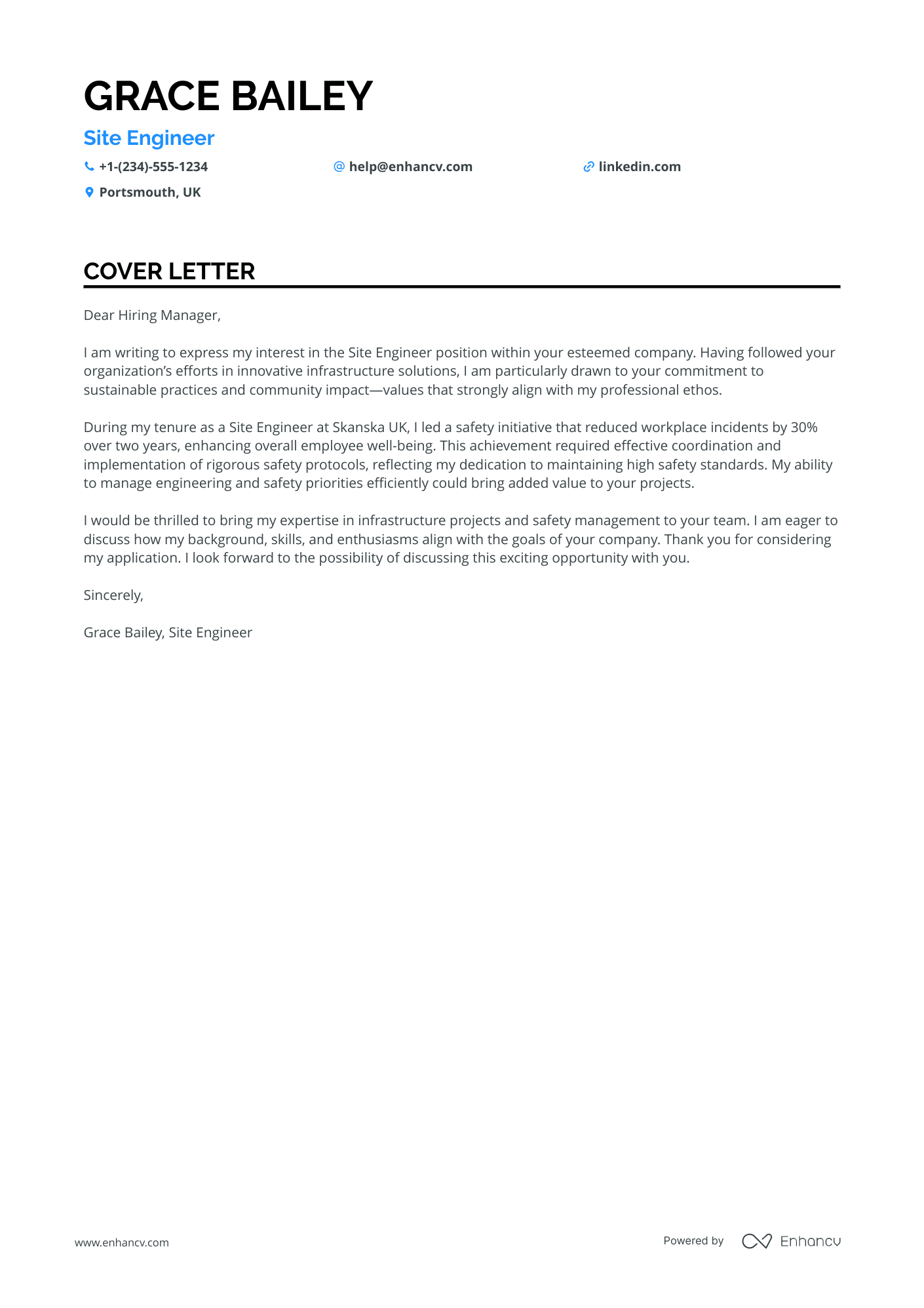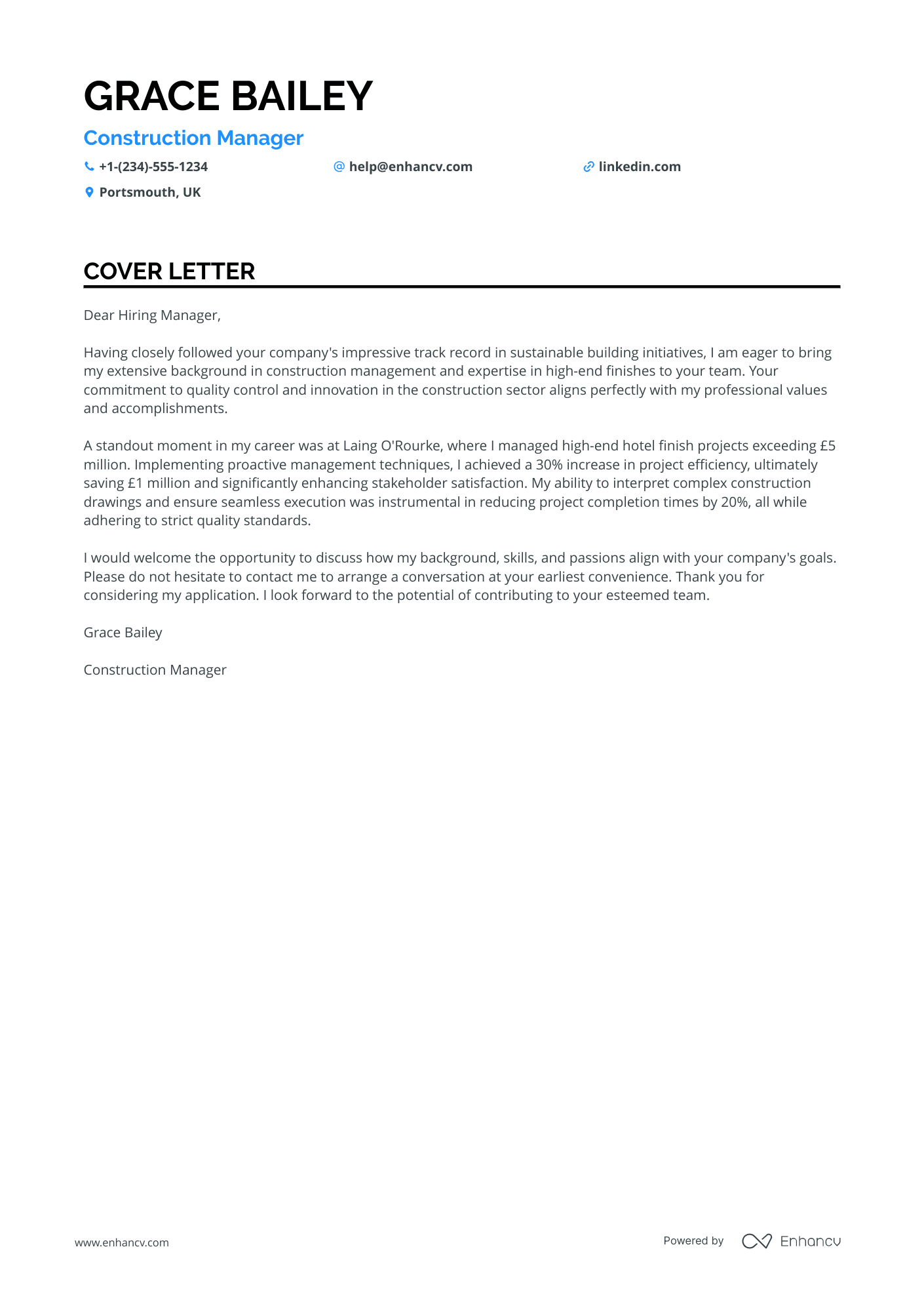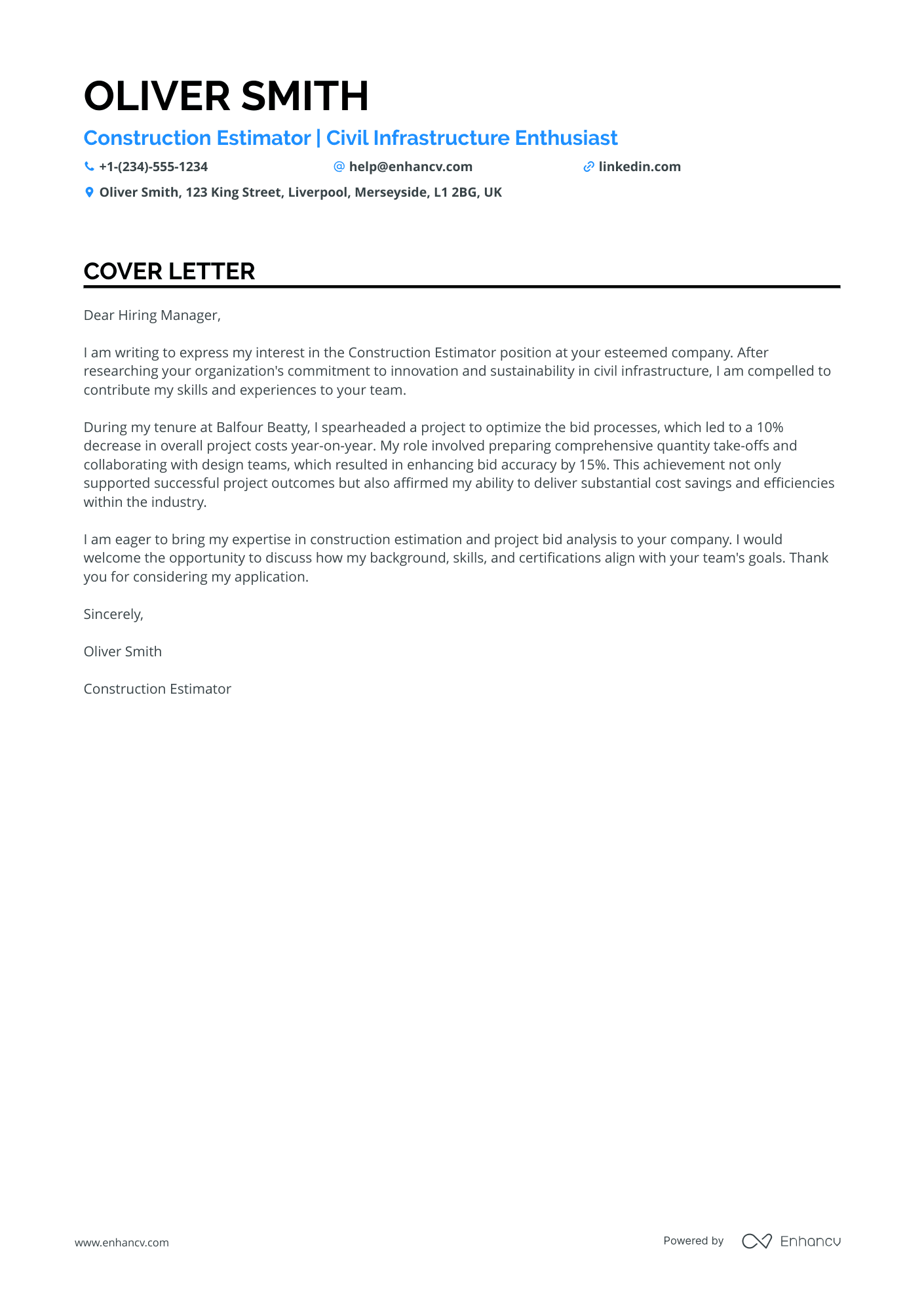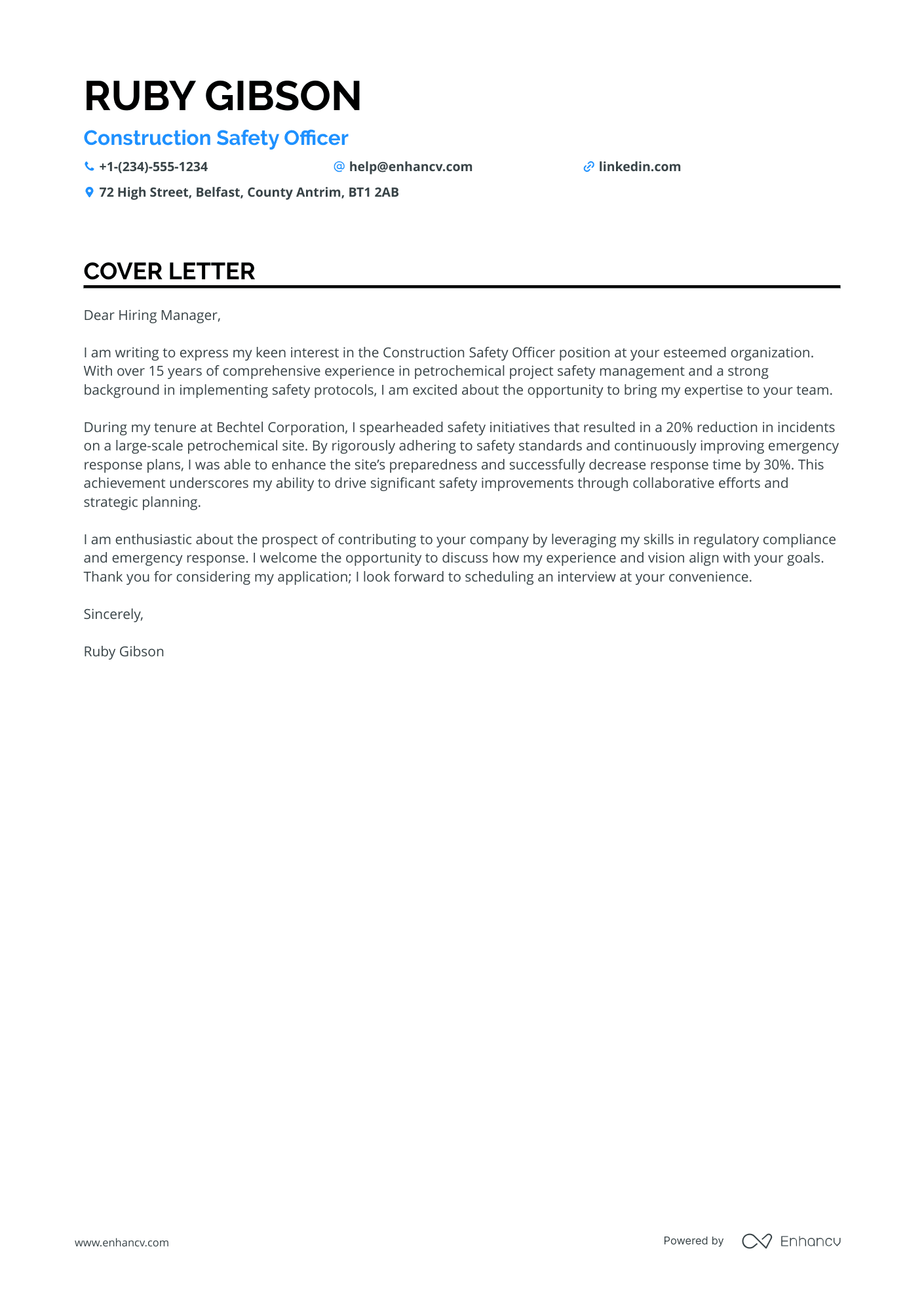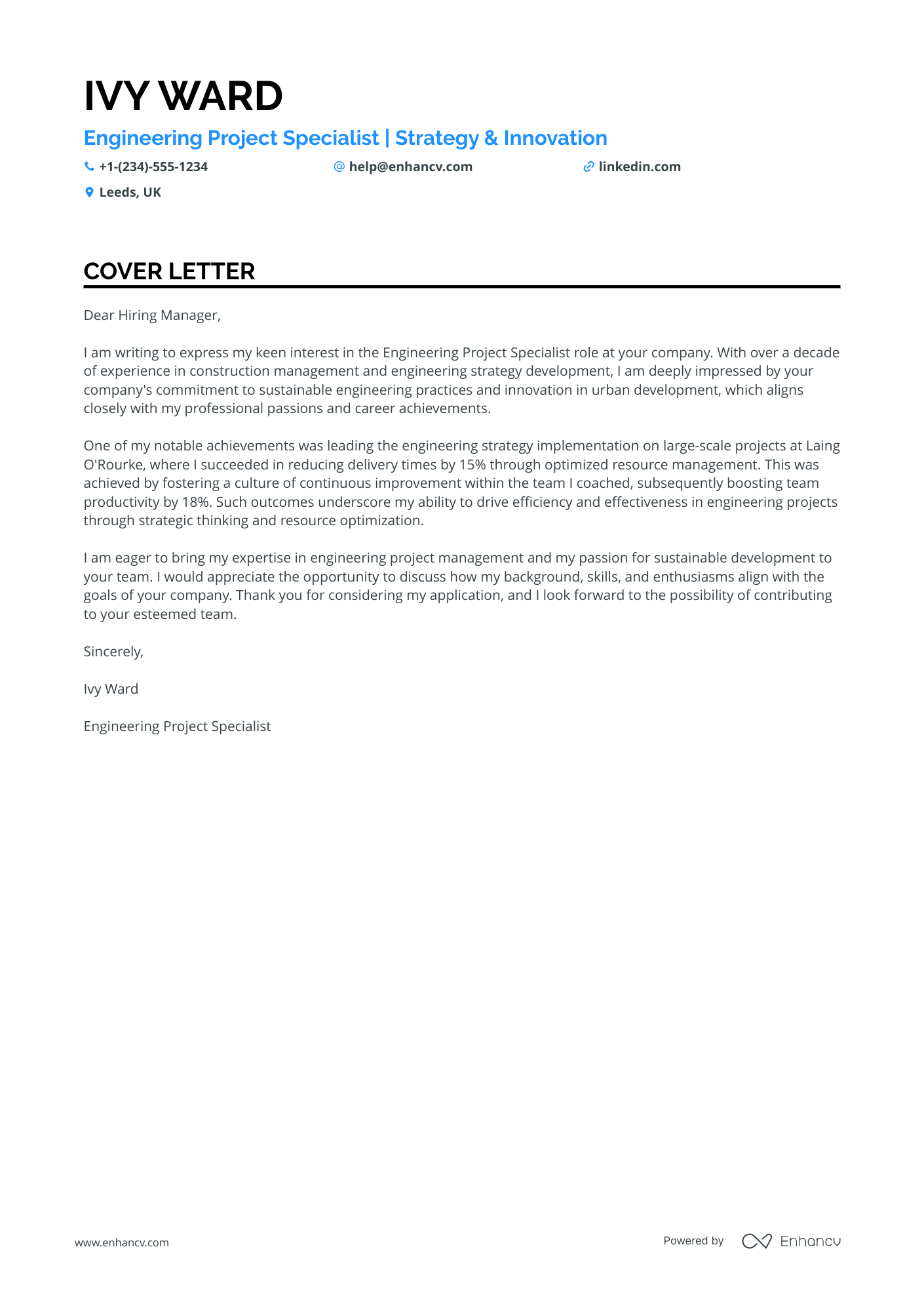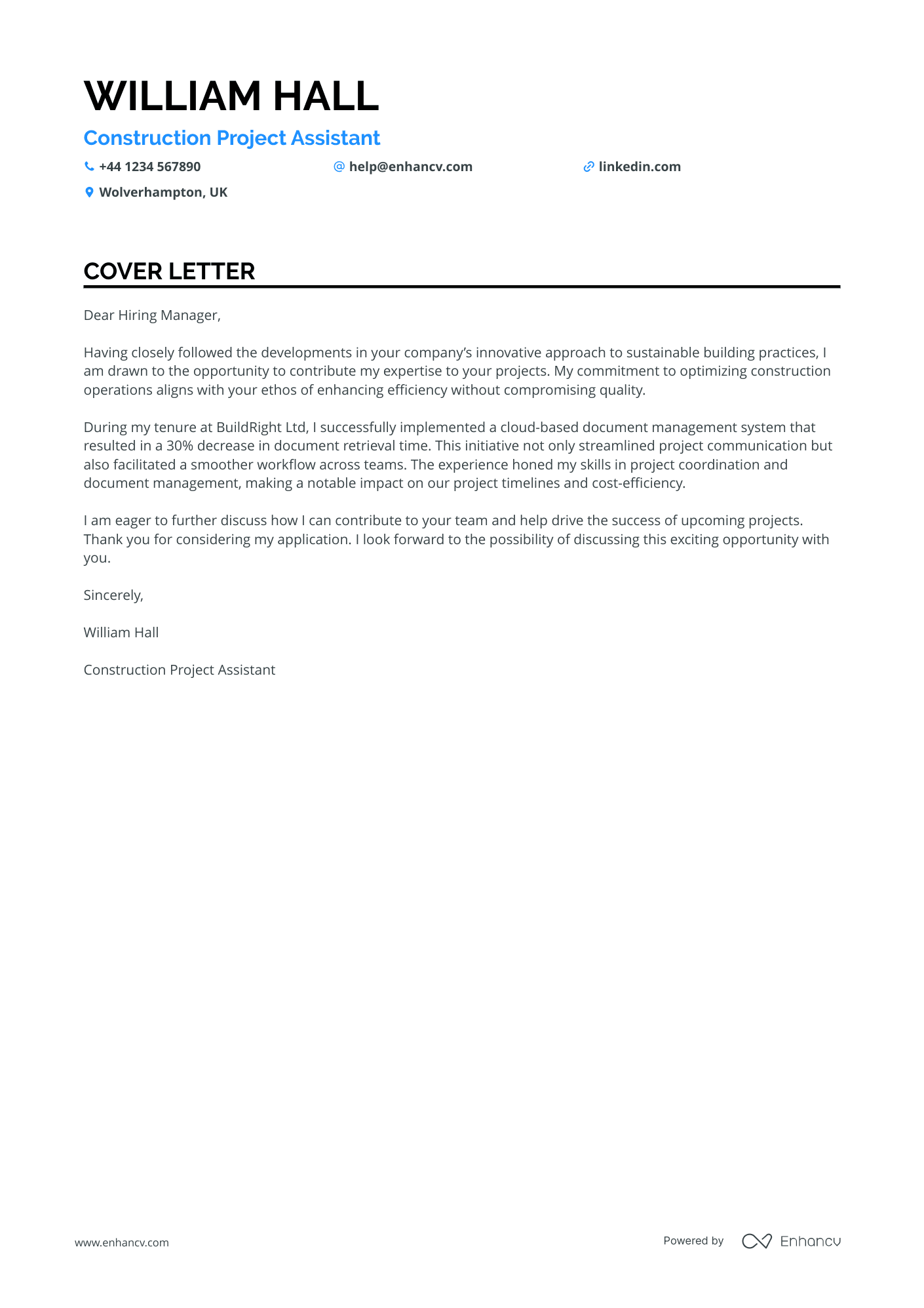Congratulations on completing your first cover letter. However, as you look back, you realise it’s simply a copy-paste of your CV.
Repeating your curriculum vitae is a common pitfall that many candidates encounter, making the cover letter redundant.
Your cover letter should provide fresh insights, adding more value to your application. It’s also the ideal space to address career gaps or major transitions that might not be covered in your CV.
In this guide, you’ll learn how to use your cover letter to demonstrate why you’re the best candidate for the role, while confidently addressing your career history and key achievements.
Cover letter examples for construction
By Experience
Junior Construction Site Engineer
- Emphasise the experience in infrastructure projects, particularly detailing the individual’s capability to lead and improve workflow efficiency and quality assurance, demonstrating a strong foundation in similar roles.
- Highlight certifications such as the "Advanced GPS Surveying" and "Construction Safety Management" which directly align with industry requirements and demonstrate ongoing professional development in essential skills.
- Include specific achievements like "Implemented Innovative Survey Techniques" and "Enhanced Site Safety Standards," which are key in showcasing the individual’s proven track record in significant areas crucial to site engineering.
- Focus on leadership capabilities illustrated through mentoring and collaboration, evidencing the individual’s ability to guide teams and innovate processes, vital for roles with managerial or leadership responsibilities.
Entry-level Construction Estimator
- Specific Experience Highlights: Emphasising track record with leading companies like Balfour Beatty and Kier Group, detailing relevant accomplishments like improving cost estimation accuracy and reducing project delays showcases proven competency.
- Relevant Education and Certifications: Listing qualifications in Civil Engineering and Construction Management from reputable universities supports expertise. Highlighting certifications such as "Construction Project Management" adds credibility.
- Relevant Skills: Stating skills directly related to the role, such as "Construction Estimation", "Project Bid Analysis", and proficiency in tools like Bluebeam, aligns with the job's requirements.
- Passion for the Industry: Expressing interests, such as green infrastructure development, demonstrates a commitment to and enthusiasm for the field, potentially aligning with company values.
Experienced Construction Safety Officer
- Highlighting Certifications: Including relevant certifications such as the NEBOSH International General Certificate, which demonstrates a comprehensive understanding of safety management principles, is crucial for a Construction Safety Officer focused on high-risk operations.
- Emphasising Experience: Detail specific achievements such as reducing incident rates by 30%, which underscore the candidate's proven ability to implement effective safety protocols and audits, providing tangible proof of competency and success.
- Showcasing Leadership: Mentioning leadership in safety training programs and supervising a team of safety officers highlights the candidate's capability to inspire and manage teams, vital for senior safety roles.
- Industry-Specific Skills: Citing skills such as OSHA Standards and Heavy Lifting Safety illustrates the candidate's expertise in critical regulatory areas and technical competencies essential in managing construction safety effectively.
By Role
Construction Site Foreman
- The cover letter effectively highlights the candidate's extensive experience in high-end finishes and quality control, adding value to their application for a Construction Manager position, especially in luxury projects.
- Grace's experience in managing large-scale projects with significant budgets is emphasised, showcasing their capability to handle complex and demanding roles while maintaining high-quality standards.
- Key achievements, such as a 30% increase in project efficiency and a zero-incident safety record, demonstrate the candidate's proactive management style and commitment to safety and efficiency, critical to a Construction Manager role.
- The inclusion of clear, quantifiable success metrics (e.g., a 15% improvement in deadline adherence) strengthens the cover letter by providing concrete evidence of performance and expertise.
Construction Estimator
- Highlight Specific Certifications: Mention relevant certifications such as the "Data Centre Construction Techniques" certification from BICSI, which is crucial for someone in a role focused on data centre construction and estimating.
- Emphasise Quantifiable Achievements: Bring attention to quantifiable achievements like achieving a £5M cost-saving on a major project and maintaining a 99% accuracy rate in project budgeting, which demonstrate expertise and success in cost management.
- Include Relevant Technical Skills: Highlight key technical skills like Microsoft Excel, AutoCAD, and Primavera P6, which are essential for a role that involves detailed construction estimating and cost control.
- Showcase Leadership and Process Improvement: Emphasise contributions to process improvements, such as implementing standardised estimating processes across teams, which enhance project consistency and accuracy.
Construction Safety Officer
- Highlight extensive experience in the field by emphasising the 15+ years of expertise in construction safety, specifically in high-risk petrochemical projects.
- Emphasise the significant contributions made through specific achievements, such as a 20% reduction in incidents and a 25% decrease in crane-related issues, showcasing the impact on site safety and efficiency.
- Mention specialised certifications and courses, like the NEBOSH International General Certificate and OSHA 30-Hour Construction Safety course, which demonstrate a solid understanding and dedication to maintaining safety standards.
- Showcase leadership in emergency management by describing successful initiatives, such as improving emergency response times by 30%, to underline the role's proactive and strategic approach to safety improvements.
Construction Equipment Operator
- Relevant Experience: Charlotte's cover letter effectively highlights over 7 years of experience in operating heavy machinery, specifically in excavation and grading, which directly aligns with her role as a Heavy Equipment Operator.
- Technical Skills: The mention of proficiency in using Topcon machine control systems is crucial, as it showcases her capability in operating advanced technology, enhancing construction efficiency.
- Safety and Maintenance Focus: By emphasising a proactive maintenance approach and leading safety protocol initiatives, Charlotte demonstrates a commitment to safety and equipment longevity, reducing downtime and accidents.
- Leadership and Teamwork: The cover letter underscores her leadership skills and teamwork by detailing achievements such as leading teams in significant projects and developing cross-training programmes, which are essential in construction project settings.
Construction Site Engineer
- Highlighting Achievements: The cover letter effectively uses quantifiable achievements, such as improving project performance by 20% and reducing delivery time by 15%, to demonstrate value and capability in engineering project management.
- Emphasising Relevant Skills and Experience: Key skills such as BIM, Quality Assurance, and Safety Management are prominently featured, aligning with the role of an Engineering Project Specialist and showcasing expertise in areas crucial for the position.
- Incorporating Certifications and Education: Mention of specialised courses and advanced degrees, like the Master of Engineering in Civil Engineering, enhances the credibility and expertise of the applicant in specialised engineering fields.
- Demonstrating Leadership and Team Building: The applicant's experience in coaching project teams and improving productivity by 18% highlights leadership qualities essential for roles involving strategy and innovation.
Construction Surveyor
- Experience and Skill Set Alignment: The cover letter effectively highlights the candidate's extensive experience in project management, data analysis, and building surveying. These skills are crucial for a Building Surveyor role, showcasing proficiency in managing large-scale projects and ensuring compliance with building codes.
- Quantifiable Achievements: The letter includes specific, measurable achievements, such as a 15% reduction in safety breaches and a 20% increase in project efficiency. This demonstrates the candidate's impact in previous roles and their ability to deliver tangible results.
- Relevant Education and Certifications: The candidate mentions relevant educational background, with a Master of Science in Construction Project Management, and additional courses such as Advanced Building Inspection Techniques, which are pertinent for the role and suggest continued professional development.
- Alignment with Industry Trends: Expressing an interest in sustainable architecture and engagement with urban development projects indicates the candidate's forward-thinking approach and awareness of current and future industry trends.
Construction Planner
- Highlighting professional achievements such as reducing project delivery times by 25% and achieving substantial cost savings adds credibility and showcases specific areas of expertise.
- Mention of relevant certifications, such as the Construction Planning and Management Certification by RICS, reinforces specialised knowledge and continuous professional development.
- References to advanced skills like technological integration and strategic coordination demonstrate the candidate's ability to handle complex project requirements in a construction environment.
- Including quantifiable outcomes in descriptions, e.g., increased scheduling accuracy by 40% or reducing client response times by 50%, helps in emphasising concrete impacts made in previous roles.
Construction Cost Consultant
- Highlighting specialised skills like "Value Management" and "Contract Administration" that directly relate to cost consultancy roles enhances the applicant's relevance to the position.
- The inclusion of quantifiable achievements, such as a "30% cost reduction on a hospital project," provides concrete evidence of the candidate's effectiveness and ability to deliver results.
- Emphasising leadership experience, such as "Led a team in implementing cost management procedures," demonstrates management capabilities valuable for senior roles.
- Referencing relevant certifications and courses, like the "Advanced Contract Administration" course focused on JCT and NEC contracts, underlines the applicant's commitment to professional development and industry standards.
Construction Logistics Coordinator
- Highlight Specific Experience: Emphasise direct experience in managing logistics for large-scale construction projects, such as the £50M project, as it reflects the candidate's capacity to handle significant responsibilities and contribute to project success.
- Demonstrate Achievements Quantitatively: Use numbers to showcase accomplishments, like a 30% improvement in resource allocation efficiency or £50,000 cost savings, to provide concrete evidence of impact.
- Tailor Skills to the Role: Enhance relevance by focusing on specific skills such as Inventory Management, Cost Control, and Compliance Management, which align well with the logistics coordinator role in construction.
- Include Certifications and Training: Mention certifications in Construction Safety and Compliance and Advanced Logistics Management, which reaffirm expertise and a commitment to professional development in logistics.
Construction Design Coordinator
- Emphasising expertise and experience in design coordination and project management is crucial, as these are core responsibilities in roles such as Design Coordinator and similar positions within construction. Louis Wood effectively highlights his experience in managing design processes and stakeholder communications to demonstrate his capability in these areas.
- The mention of specific achievements, such as implementing design review processes that significantly reduced design errors by 40% and coordinating a high-value £10 million project, strengthens the application by showcasing tangible results and success in managing substantial projects.
- Including relevant continuing education, such as the courses in Project Management for Construction Professionals and Advanced Design Coordination Techniques, highlights a commitment to staying updated with industry standards and practices, which is essential for roles involving project coordination and management.
- Demonstrating passion for sustainable construction and innovative architecture aligns well with the evolving priorities of the construction industry towards more environmentally friendly practices, potentially setting the applicant apart as a forward-thinking candidate.
Construction Contract Administrator
- Certifications and Courses: Highlight the Advanced Data Management certification from Belbin Training to demonstrate proficiency in accurate data handling and analysis, vital for enhancing operational efficiency in administrative support roles.
- Quantifiable Achievements: Mention specific metrics like achieving a 30% reduction in invoice processing times and saving £5,000 annually through verification campaigns to showcase effectiveness in cost control and process optimisation.
- Relevant Experience: Provide details about handling purchase orders and invoice queries at Mitie Group PLC, resolving 95% of issues within 48 hours, to highlight problem-solving capabilities and enhance vendor relations, which are key for an administrative role.
- Technical Skills: Emphasise proficiency in the Microsoft Office Suite, especially for roles reliant on software for logistical coordination and report preparation, illustrating the ability to improve accuracy and efficiency in administrative tasks.
Construction Site Clerk
- Emphasising expertise in nuclear safety compliance and quality assurance showcases Evie's niche skills crucial for roles involving nuclear projects, setting her apart from other candidates in the construction sector.
- Highlighting significant cost reductions and safety protocol enhancements not only demonstrates Evie's capability to manage budgets effectively but also her commitment to maintaining high safety standards.
- Mentioning key certifications such as IOSH Managing Safety and NEBOSH Certification reinforces her credibility and ensures potential employers of her commitment to maintaining high industry standards.
- Showcasing leadership and mentoring skills through the development of safety workshops and peer-recognition programs reflects positively on Evie's capability to lead teams and encourage a culture of improvement and safety.
Construction cover letter example
William Hall
Wolverhampton, UK
+44 1234 567890
help@enhancv.com
- Emphasize your commitment to the company's mission or values, particularly if they align with sustainability or innovation in construction, as this demonstrates a strong cultural fit.
- Highlight specific achievements that showcase your skills and contributions, such as implementing a system that improves efficiency and saves time, to demonstrate your capability and experience.
- Mention relevant technical skills, such as familiarity with cloud-based systems or project management tools, that are crucial for the role to demonstrate your technical competency.
- Express enthusiasm for the opportunity and how you can add value to the company, which shows that you are proactive and invested in the role.
Importance of cover letters in the United Kingdom
Cover letters provide recruiters with the opportunity to learn more about your career aspirations, hinting at how you’d integrate within the organisation over the long term.
Here are three additional reasons why cover letters are important:
- Making an excellent first impression (and a formal introduction): Your cover letter is often the employer’s first introduction to you, showcasing your personality, communication skills, and motivation for the role.
- Complementing your career history: While your CV lists qualifications and experience, a cover letter provides the context, explaining how your background fits the role.
- Demonstrates your genuine interest: A well-crafted cover letter reflects the effort you’ve put into researching the company and role as well as your attention to detail.
What UK employers expect from a cover letter
You only have one chance to impress your potential UK employers, so be wise about writing your cover letter.
When doing so, follow these three simple but essential steps:
- Do your research: Begin by researching the company and the role you're applying for. Check their website, social media pages, and relevant news to understand what drives their business.
- Highlight company values: Identify the company's core beliefs and explain how your personal and professional experiences resonate with them. For instance, if the organisation prioritises innovation, provide examples where you've demonstrated creative thinking.
- Match your skills to the job: Analyse the job description carefully and pick out the most important skills or qualifications they’re seeking. Be sure to mention your relevant achievements that prove you're the perfect fit for the position.
How to format a construction cover letter
Your cover letter is your opportunity to make a strong impression, so its structure must be professional and clear.
Here's an overview of how a UK cover letter should be structured:
- Begin with your address and contact details at the top.
- Include the employer’s name and address directly below.
- Add the date to the left or right of the page.
- Use an appropriate greeting, such as 'Dear Mr Smith' or 'Dear Sir/Madam.'
- Open with a strong introductory paragraph.
- Develop your points in the middle paragraphs, focusing on relevant skills and experience.
- Close with a concise conclusion, reiterating your interest and suitability for the role.
- Sign off formally with your name and signature.
The software used to match your profile to the job, Applicant Tracking Systems (ATS), won’t scan your cover letter. Instead, the cover letter reads as a more personalised note to the recruiter.
When it comes to choosing a font, consider modern options like Lato, Rubik, or Chivo, which should also be applied to your CV to maintain a consistent appearance.
Additionally, your cover letter should be single-spaced with 1-inch (2.5 cm) margins on all sides (our templates are pre-set with these specifications so you can focus on your cover letter content).
Finally, always send your cover letter as a PDF to preserve the formatting and prevent edits.
How to write your construction cover letter salutation
It's never advisable to begin your cover letter with 'Dear Sir/Madam', as it sounds comes across as impersonal.
Take the time to find out who is hiring for the role and address them directly in your cover letter greeting (e.g., 'Dear Mrs Chanceworth', 'Dear Harrod').
If you're uncertain where to find the hiring manager’s name, check the company website, look on LinkedIn, or send a courteous email requesting this information. Don't hesitate to ring reception either—they are unlikely to refuse to assist.
How to write your construction cover letter intro
It's never a bad time to show enthusiasm about the role, company, or team in your cover letter introduction.
Begin by sharing one or two aspects that genuinely excite you about the position—whether it's the company culture, specific responsibilities, or the team's past achievements.
Your enthusiasm demonstrates that you'll bring a strong work ethic, are eager to contribute, and are motivated to succeed.
How to write your construction cover letter body
You’ve personalised your greeting and introduction—now it’s time to focus on writing the body of your cover letter.
Instead of listing off skills and responsibilities from your CV, focus on one career highlight that’s relevant to the role.
Use your hard and soft skills, success metrics (e.g., percentages or sales figures), and the long-term impact it had on the company.
A concise, well-told story centred on your value as a candidate will make a strong impression.
How to write a closing paragraph
Now we’ve reached the closing paragraph of your cover letter. You might be tempted to end with a simple Yours sincerely, but don’t!
Instead, finish with a promise to enhance the company’s performance metrics (backed by your hard and soft skills), to develop as a professional, or something else that holds significance for the organisation. Whatever you choose, ensure to stand behind your words and be remain sincere.
Don’t forget to include a call to action, encouraging recruiters to suggest the best time to follow up for an interview or update.
Conclusion
Creating a compelling cover letter is vital in making a positive first impression on potential employers. Personalise your letter by addressing the hiring manager directly and ensuring your skills align with the job description.
Highlight specific achievements that demonstrate your suitability for the role, and express genuine enthusiasm for the opportunity. Finally, maintain a professional format that complements your CV for a cohesive application.
